Eucalol
Série 293 – "As Dansas Através do Mundo"
Texto extraído do verso das Estampas
Das Coleções do Rio de Janeiro
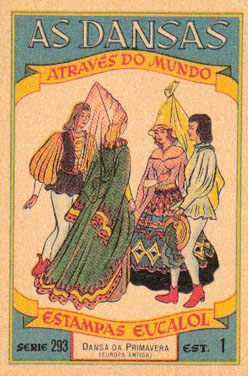
DANÇA
DA PRIMAVERA
(Europa Antiga)
Os
povos primitivos da Europa conheceram, amaram e cultivaram as danças.
Agricultores em maioria, os primeiros indo-europeus adoravam a Natureza
e as danças eram ligadas com o sol, a lua, a terra, as chuvas,
a fertilidade, etc.
Aqui vemos jovens eslavas celebrando a chegada da Primavera. Mês
de maio.
SPRING
DANCE
(Old Europe)
Primitive
peoples of Europe knew, loved and nurtured the dances.
Most farmers in the first Indo-Europeans worshiped nature and the dances
were connected with the sun, moon, earth, rain, fertility, etc..
Here we see young Slavic celebrating the arrival of spring. May.
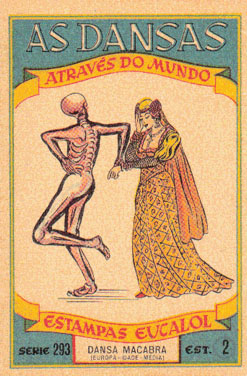
DANÇA
MACABRA
(Europa – Idade Média)
Durante
a Idade Média a humanidade foi presa de extranho frenesi que nós
chamamos de dança macabra. Esta dança era executada geralmente
nos cemitérios.
Essa forma alucinada da dança chegou a manifestar-se várias
vezes na história europea.
No século XIV sob o nome de dança de São Vito e mais
tarde na Itália em forma de tarantismo.
MACABRE
DANCE
(Europe - Middle Ages)
During
the Middle Ages humanity was prey to strange frenzy that we call the danse
macabre. This dance was usually performed in cemeteries.
This form of dance crazy has come to manifest itself several times in
European history.
In the fourteenth century under the name of St. Vitus dance and later
in Italy in the form of tarantismo.
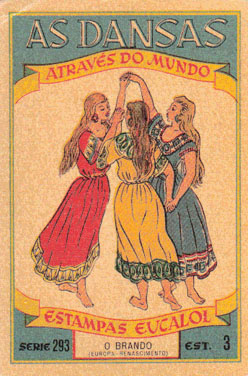
O
BRANDO
( Europa – Renascimento)
Dança
predileta da sociedade europea na época do Renascimento. É
uma Ronda com numerosas figuras, lentas no início e muito vivas
no fim.
Passear, brincar, correr – tal era a sucessão tradicional
dos Brandos.
The
BRANDO
(Europe - Rebirth)
Europea
favorite dance society during the Renaissance. It's a round with numerous
figures, slow at first and very much alive in the end.
Walk, play, run - such was the succession of traditional Brandos.
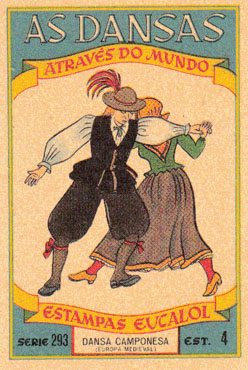
DANÇA
CAMPONESA
(Europa Medieval)
A
dança camponesa do século XV foi a origem de todas as danças
desse gênero que se encontram na Europa.
Era uma dança animada, cuja principal característica é
de ser dançada por um par, e em que o rapaz procura cortejar a
moça. Ela finge fugir, depois volta a provocá-lo e foge
de novo, enquanto o rapaz se entrega a toda espécie de saltos graciosos
ou cômicos para tratar de conquistar a moça.
RURAL
DANCE
(Medieval Europe)
The
peasant dance of the fifteenth century was the origin of all the dances
of this kind which are in Europe.
It was a lively dance, whose main characteristic is to be danced by a
couple, and that the boy seeks to woo the girl. She pretends to run away,
then back to tease him and runs away again, as the boy gives in every
kind of comic or graceful leaps to try to win the girl.
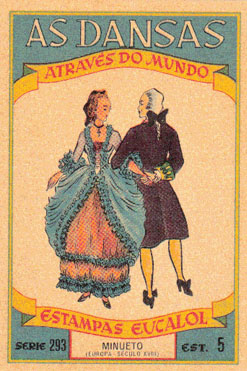
MINUETO
(Europa – Século XVIII)
O
minueto foi a dança predileta de todos o salões europeus
no século XVIII. Na corte da França, nos deslumbrantes salões
de Luiz XIV, O Rei Sol, o minueto triunfava. Era uma dança lenta,
porém, graciosa e leve, feita só de movimentos graves.
A impressão geral era de dignidade, grandeza e serenidade, como
convinha a uma época tão brilhante.
MINUET
(Europe - Eighteenth Century)
The
minuet was the favorite dance of all the European salons in the eighteenth
century. In the court of France, in the sumptuous rooms of Louis XIV,
the Sun King, the minuet was triumphant. It was a slow dance, but graceful
and light, made only serious moves.
The general impression was of dignity, grandeur and serenity, as befitted
a brilliant season.
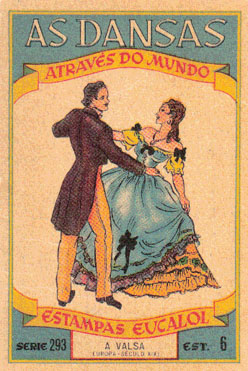
A
VALSA
(Europa – Século XIX)
De
origem vienense, a valsa aparece no fim do século XVIII e nos salões
da alta sociedade e espalha-se rapidamente pela Europa e América
do Norte.
A valsa representa uma reação impetuosa contra o formalismo
petrificado das danças do fim do grande século.
Expressão, alma, paixão, são suas características.
(brasilcult)
A
WALTZ
(Europe - Nineteenth Century)
Source
Viennese waltz appears in the late eighteenth century and in the salons
of high society and spreads rapidly through Europe and North America.
The waltz is a fierce reaction against formalism petrified of the dances
of the end of the great century.
Expression, soul, passion, are their characteristics.